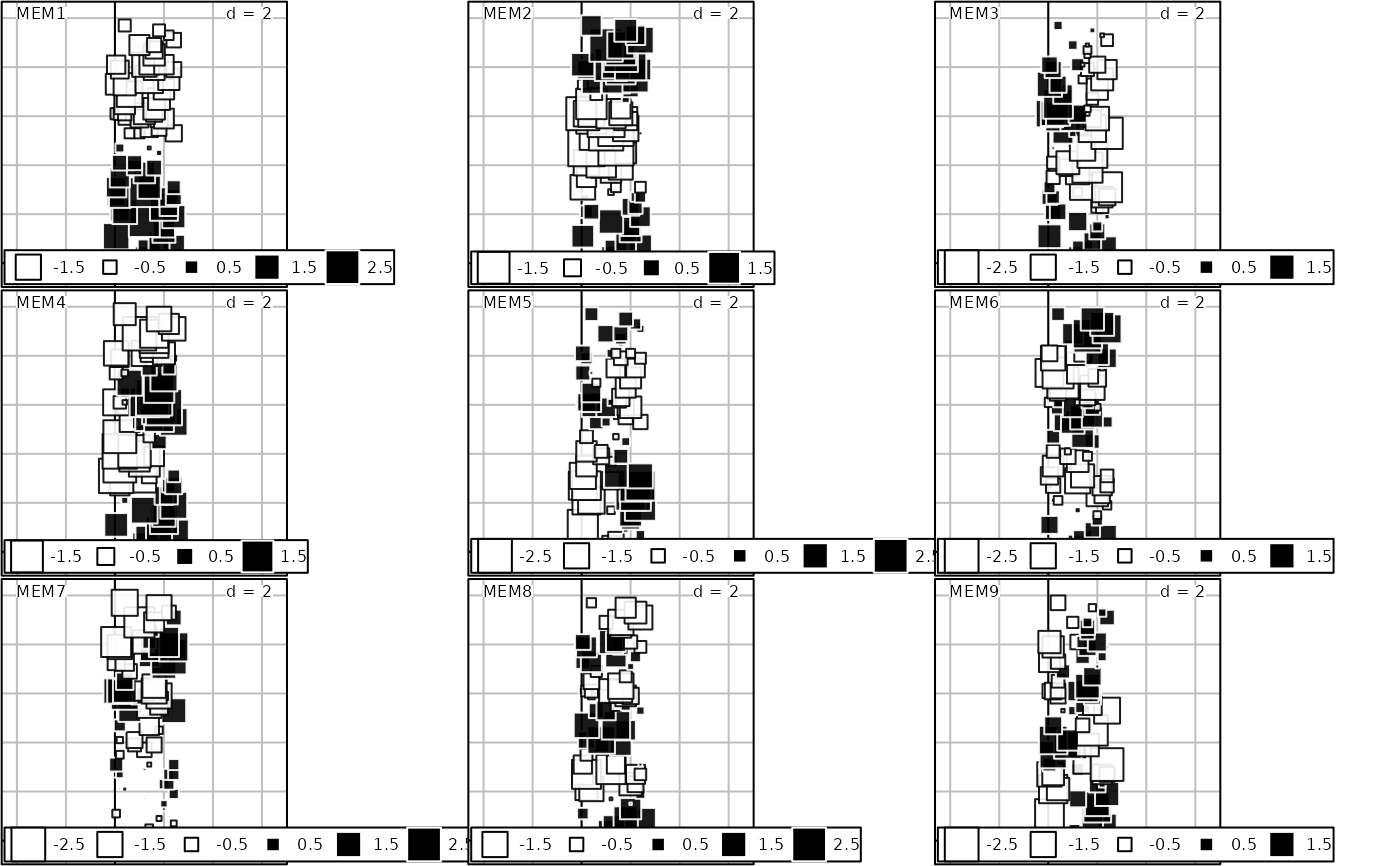Function to compute and manage Moran's Eigenvector Maps (MEM) of a listw object
Source:R/scores.listw.R
mem.RdThese functions compute MEM (i.e., eigenvectors of a doubly centered spatial weighting matrix). Corresponding eigenvalues are linearly related to Moran's index of spatial autocorrelation.
scores.listw(
listw,
wt = rep(1, length(listw$neighbours)),
MEM.autocor = c("non-null", "all", "positive", "negative"),
store.listw = FALSE
)
mem(
listw,
wt = rep(1, length(listw$neighbours)),
MEM.autocor = c("non-null", "all", "positive", "negative"),
store.listw = FALSE
)
orthobasis.listw(
listw,
wt = rep(1, length(listw$neighbours)),
MEM.autocor = c("non-null", "all", "positive", "negative"),
store.listw = FALSE
)
# S3 method for class 'orthobasisSp'
x[i, j, drop = TRUE]Arguments
- listw
An object of the class
listwcreated by functions of thespdeppackage- wt
A vector of weights. It is used to orthogonalize the eigenvectors. It could be useful if MEM are used in weighted regression or canonical correspondence analysis
- MEM.autocor
A string indicating if all MEMs must be returned or only those corresponding to non-null, positive or negative autocorrelation. The difference between options
allandnon-nullis the following: when there are several null eigenvalues, optionallremoves only one of the eigenvectors with null eigenvalues and returns (n-1) eigenvectors, whereasnon-nulldoes not return any of the eigenvectors with null eigenvalues.- store.listw
A logical indicating if the spatial weighting matrix should be stored in the attribute
listwof the returned object- x
An object of class
orthobasisSp.- i, j
Elements to extract (integer or empty): index of rows (i) and columns (j).
- drop
A logical. If TRUE, object containing only one colum is converted in vector
Value
An object of class orthobasisSp , subclass orthobasis.
The MEMs are stored as a data.frame. It contains several attributes
(see ?attributes) including:
listw: The associated spatial weighting matrix (ifstore.listw = TRUE).
Details
Testing the nullity of eigenvalues is based on E(i)/E(1) where E(i) is i-th eigenvalue and E(1) is the maximum absolute value of eigenvalues
References
Dray, S., Legendre, P., and Peres-Neto, P. R. (2006). Spatial modeling: a comprehensive framework for principal coordinate analysis of neighbor matrices (PCNM). Ecological Modelling 196, 483–493.
Griffith D. A. (1996) Spatial autocorrelation and eigenfunctions of the geographic weights matrix accompanying geo-referenced data. Canadian Geographer 40, 351–367.
See also
Examples
if(require("ade4", quietly = TRUE) & require("spdep", quietly = TRUE)){
data(oribatid)
nbtri <- tri2nb(as.matrix(oribatid$xy))
sc.tri <- scores.listw(nb2listw(nbtri, style = "B"))
summary(sc.tri)
}
#> Orthonormal basis: data.frame with 70 rows and 69 columns
#> ----------------------------------------------------------------
#> Columns form a centred orthonormal basis (i.e. 1n-orthogonal)
#> for the inner product defined by the 'weights' attribute
#> ----------------------------------------------------------------
#>
#> Attributes:
#> - names: MEM1 ... MEM69
#> - row.names: 1 ... 70
#> - weights: 0.01428571 ... 0.01428571
#> - values: 0.07805391 ... -0.04134591
#> - class: orthobasisSp orthobasis data.frame
#> - call: scores.listw(listw = nb2listw(nbtri, style = "B"))
#>
if(require("adegraphics", quietly = TRUE)){
s.value(oribatid$xy,sc.tri[,1:9])
plot(sc.tri[,1:6], oribatid$xy, pSp.cex = 5, pSp.alpha = 0.5, pbackground.col = 'lightblue')
}
 #> Error in h(simpleError(msg, call)): error in evaluating the argument 'obj' in selecting a method for function 'coordinates': object 'sc.tri' not found
#> Error in h(simpleError(msg, call)): error in evaluating the argument 'obj' in selecting a method for function 'coordinates': object 'sc.tri' not found